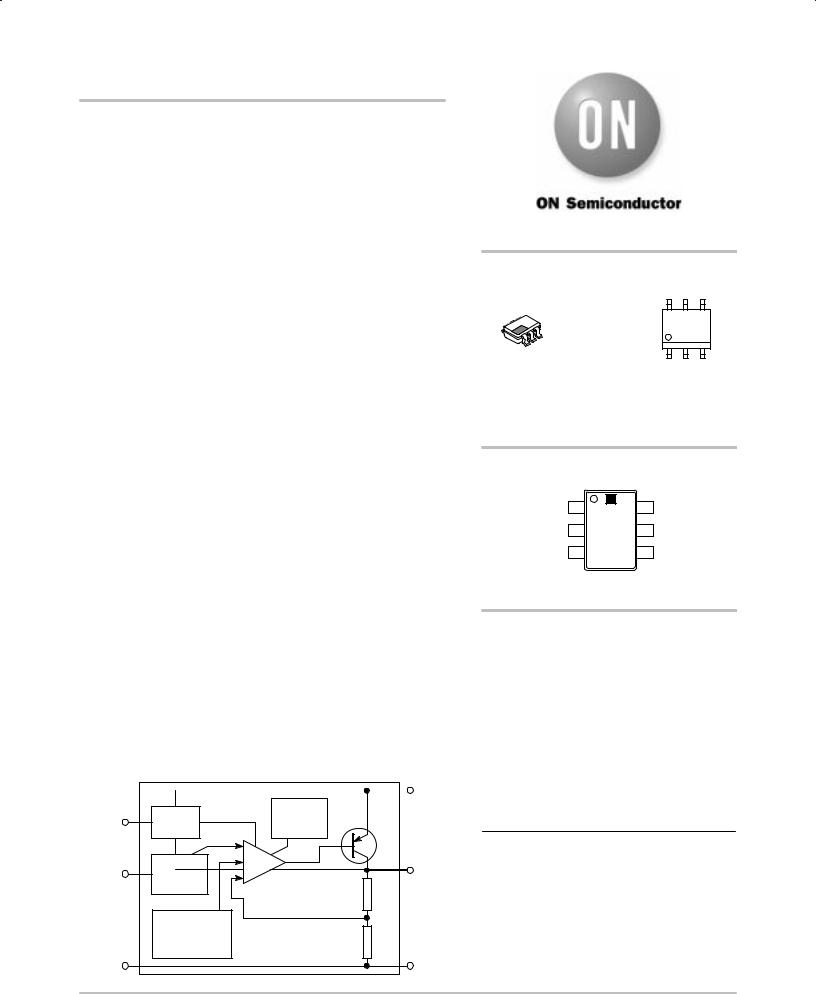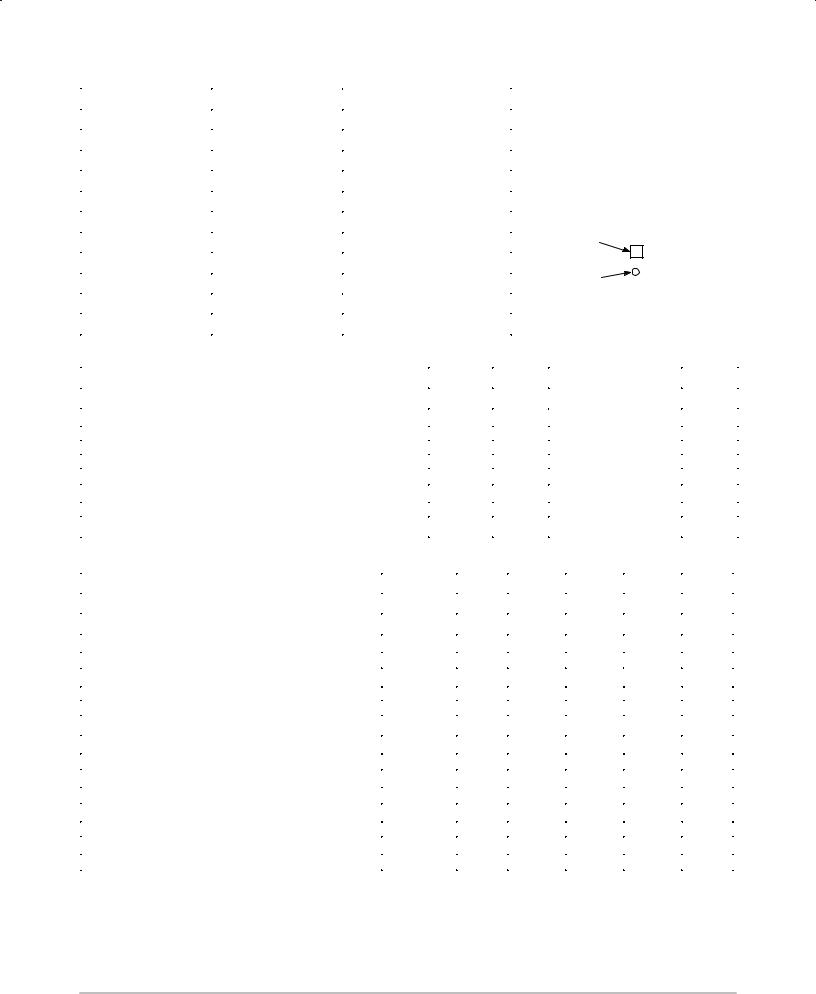MOTOROLA MC33263NW-28R2, MC33263NW-30R2, MC33263NW-38R2, MC33263NW-40R2, MC33263NW-47R2 Datasheet
...
MC33263
Ultra Low Noise 150 mA Low Dropout
Voltage Regulator with ON/OFF Control
Housed in a SOT23±L package, the MC33263 delivers up to 150 mA where it exhibits a typical 180 mV dropout. With an incredible noise level of 25 mVRMS (over 100 Hz to 100 kHz, with a 10 nF bypass capacitor), the MC33263 represents the ideal choice for sensitive circuits, especially in portable applications where noise performance and space are premium. The MC33263 also excels in response time and reacts in less than 25 ms when receiving an OFF to ON signal (with no bypass capacitor).
Thanks to a novel concept, the MC33263 accepts output capacitors without any restrictions regarding their Equivalent Series Resistance (ESR) thus offering an obvious versatility for immediate implementation.
With a typical DC ripple rejection better than ±90 dB (±70 dB @ 1 kHz), it naturally shields the downstream electronics against choppy power lines.
Additionally, thermal shutdown and short±circuit protection provide the final product with a high degree of ruggedness.
Features:
•Very Low Quiescent Current 170 μA (ON, no load), 100 nA (OFF, no load)
•Very Low Dropout Voltage, typical value is 137 mV at an output current of 100 mA
•Very Low Noise with external bypass capacitor (10 nF), typically 25 μVrms over 100 Hz to 100 kHz
•Internal Thermal Shutdown
•Extremely Tight Line Regulation typically ±90 dB
•Ripple Rejection ±70 dB @ 1 kHz
•Line Transient Response: 1 mV for DVin = 3 V
•Extremely Tight Load Regulation, typically 20 mV at DIout = 150 mA
•Multiple Output Voltages Available
•Logic Level ON/OFF Control (TTL±CMOS Compatible)
•ESR can vary from 0 to 3W
•Functionally and Pin Compatible with TK112xxA/B Series
Applications:
•All Portable Systems, Battery Powered Systems, Cellular Telephones, Radio Control Systems, Toys and Low Voltage Systems
|
|
MC33263 Block Diagram |
||
|
|
|
6 |
|
|
|
|
Input |
|
Shutdown |
1 |
ON/OFF |
Thermal |
|
|
Shutdown |
|||
|
3 |
Band Gap |
4 |
|
Bypass |
Output |
|||
|
||||
|
Reference |
|
||
|
|
|
||
*Current Limit
*Antisaturation
*Protection
2 |
5 |
GND |
GND |
http://onsemi.com
|
|
|
MARKING |
|
|
|
DIAGRAMS |
|
|
|
6 |
|
SOT±23L |
|
xAYLW |
|
NW SUFFIX |
|
|
6 |
|
|
|
CASE 318J |
|
|
|
1 |
|
1 |
|
|
|
||
x |
= Voltage Option Code |
||
A |
= Assembly Location |
||
WL, L = Wafer Lot |
|
|
|
YY, Y |
= Year |
|
|
WW, W = Work Week |
|
|
|
PIN CONNECTIONS |
|||
ON/OFF |
1 |
6 |
VIN |
GND |
2 |
5 |
GND |
BYPASS |
3 |
4 |
VOUT |
(Top View)
ORDERING INFORMATION
Device |
Version |
Shipping |
|
|
|
MC33263NW±28R2 |
2.8 V |
2500 Tape & Reel |
|
|
|
MC33263NW±30R2 |
3.0 V |
2500 Tape & Reel |
|
|
|
MC33263NW±32R2 |
3.2 V |
2500 Tape & Reel |
|
|
|
MC33263NW±33R2 |
3.3 V |
2500 Tape & Reel |
|
|
|
MC33263NW±38R2 |
3.8 V |
2500 Tape & Reel |
|
|
|
MC33263NW±40R2 |
4.0 V |
2500 Tape & Reel |
|
|
|
MC33263NW±47R2 |
4.75 V |
2500 Tape & Reel |
MC33263NW±50R2 |
5.0 V |
2500 Tape & Reel |
|
|
|
All Devices Available in SOT±23L 6 Lead Package
Semiconductor Components Industries, LLC, 2000 |
1 |
Publication Order Number: |
April, 2000 ± Rev. 2 |
|
MC33263/D |

|
|
|
MC33263 |
|
|
|
|
|
|
|
|
|
|
|
|
|
|
|
DEVICE MARKING |
|
|
|
|
|
|
|
|
|
|
|
|
|
|
|
|
|
|
|
|
|
|
|
|
|
|
|
|
|
|
|
|
|
|
|
|
|
XALYW |
|
Marking |
Version |
|
|
|
|
|
|
|
|
|
|
|
|
|
|
|
|
|
|
|
|
|
|
|
|
|
|
|
|
|
|
|
|
|
|
1st Digit |
|
A |
2.8 V |
|
|
|
|
|
|
|
|
|
|
|
|
|
|
|
|
|
|
|
|
|
|
|
|
|
|
|
|
|
|
|
|
|
|
|
|
B |
3.0 V |
|
|
|
|
|
|
|
|
|
|
|
|
|
|
|
|
|
|
|
|
|
|
|
|
|
|
|
|
|
|
|
|
|
|
|
|
C |
3.2 V |
|
|
|
|
|
|
|
|
|
|
|
|
|
|
|
|
|
|
|
|
|
|
|
|
|
|
|
|
|
|
|
|
|
|
|
|
D |
3.3 V |
|
|
|
|
|
|
|
|
|
|
|
|
|
|
|
|
|
|
|
|
|
|
|
|
|
|
|
|
|
|
|
|
|
|
|
|
E |
3.8 V |
|
|
|
|
|
|
6 |
|
5 |
|
4 |
|
|||
|
|
|
|
|
|
|
|
|
|
|
|
|
|
|
|
|
|
|
|
|
F |
4.0 V |
|
|
|
Pin 1 Ink |
|
|
|
|
|
|
|
|
|
|
|
|
|
|
|
|
|
|
|
|
|
|
|
|
|
|
||||
|
|
|
|
|
|
|
|
|
|
|
|
|
|
|
|
|
|
|
|
|
G |
4.75 V |
|
|
|
|
|
|
|
|
|||||||
|
|
|
|
Mark Identifier |
|
|
|
|
XALYW |
|||||||||
|
|
|
|
|
|
|
|
|
|
|
||||||||
|
|
|
|
|
|
|
||||||||||||
|
|
H |
5.0 V |
|
|
|
or |
|
|
|
|
|
|
|
|
|
|
|
|
|
|
|
Solid Pin 1 Dot |
|
|
|
|
|
|
|
|
|
|
||||
|
|
|
|
|
|
|
|
|
|
|
|
|
|
|
|
|
||
|
|
|
|
|
|
|
|
|
|
|
|
|
||||||
2nd Digit |
|
A |
Location Code |
|
|
|
or Dimple |
|
|
|
|
|
|
|
|
|
|
|
|
|
|
|
|
|
|
|
|
|
|
|
|
|
|||||
|
|
|
|
|
|
|
|
|
|
|
|
|
|
|
|
|
|
|
3rd Digit |
|
L |
Wafer Lot Traceability |
|
|
|
|
|
|
1 |
|
2 |
|
3 |
|
|||
|
|
|
|
|
|
|
|
|
|
|
|
|
|
|
|
|
|
|
4th/5th Digits |
|
YW |
Date Code |
|
|
|
|
|
|
|
|
SOT±23L |
||||||
|
|
|
|
|
|
|
|
|
|
|
|
|
||||||
MAXIMUM RATINGS |
|
|
|
|
|
|
|
|
|
|
|
|
|
|
|
|
|
|
|
|
|
|
|
|
|
|
|
|
|
|
|
|
|
|
|
||
|
Rating |
|
Symbol |
Pin # |
|
Value |
|
|
|
Unit |
||||||||
|
|
|
|
|
|
|
|
|
|
|
|
|
|
|
|
|
||
Power Supply Voltage |
|
|
Vin |
6 |
|
12 |
|
|
|
|
|
|
|
V |
||||
Power Dissipation and Thermal Resistance |
|
|
|
|
|
|
|
|
|
|
|
|
|
|
|
|
||
|
|
|
|
|
|
|
|
|
|
|
|
|
|
|
|
|
|
|
Maximum Power Dissipation |
|
|
PD |
|
|
|
Internally |
|
|
|
W |
|||||||
NW Suffix, Plastic Package |
|
|
|
|
|
|
Limited |
|
|
|
|
|
|
|||||
Thermal Resistance, Junction±to±Air |
|
RqJA |
|
|
|
210 |
|
|
|
|
|
|
|
°C/W |
||||
Thermal Resistance, Junction±to±Case |
|
RqJC |
|
|
|
|
|
|
|
|
|
|
|
°C/W |
||||
Operating Ambient Temperature |
|
|
TA |
|
|
|
±40 to +85 |
|
|
|
°C |
|||||||
Maximum Junction Temperature |
|
|
TJmax |
|
|
|
150 |
|
|
|
|
|
|
|
°C |
|||
Storage Temperature Range |
|
|
Tstg |
|
|
|
±60 to +150 |
|
|
|
°C |
|||||||
ELECTRICAL CHARACTERISTICS (For typical values TA = 25°C, for min/max values TA = ±40°C to +85°C, Max TJ = 150°C)
Characteristics |
Symbol |
Pin # |
Min |
Typ |
Max |
Unit |
|
|
|
|
|
|
|
CONTROL ELECTRICAL CHARACTERISTICS
Input Voltage Range |
VON/OFF |
1 |
0 |
± |
Vin |
V |
ON/OFF Input Current (All versions) |
ION/OFF |
1 |
|
|
|
mA |
VON/OFF = 2.4 V |
|
|
± |
2.5 |
± |
|
ON/OFF Input Voltages (All versions) |
VON/OFF |
1 |
|
|
|
V |
Logic ª0º, i.e. OFF State |
|
|
± |
± |
0.3 |
|
Logic ª1º, i.e. ON State |
|
|
2.2 |
± |
± |
|
|
|
|
|
|
|
|
CURRENTS PARAMETERS
Current Consumption in OFF State (All versions) |
IQOFF |
|
|
|
|
mA |
OFF Mode Current: Vin = Vout + 1.0 V, Iout = 0 mA |
|
|
± |
0.1 |
2.0 |
|
Current Consumption in ON State (All versions) |
IQON |
|
|
|
|
mA |
ON Mode Sat Current: Vin = Vout + 1.0 V, Iout = 0 mA |
|
|
± |
170 |
200 |
|
Current Consumption in Saturation ON State (All versions) |
IQSAT |
|
|
|
|
mA |
ON Mode Sat Current: Vin = Vout ± 0.5 V, Iout = 0 mA |
|
|
± |
900 |
1400 |
|
Current Limit Vin = Vout + 1.0 V, (All versions) |
IMAX |
|
|
|
|
mA |
Output Short±circuited (Note 1.) |
|
|
175 |
210 |
± |
|
|
|
|
|
|
|
|
1. Iout (Output Current) is the measured current when the output voltage drops below 0.3 V with respect to Vout at Iout = 30 mA.
http://onsemi.com
2

MC33263
ELECTRICAL CHARACTERISTICS (For typical values TA = 25°C, for min/max values TA = ±40°C to +85°C, Max TJ = 150°C)
Characteristics |
Symbol |
Pin # |
Min |
Typ |
Max |
Unit |
|
|
|
|
|
|
|
Vin = Vout + 1.0 V, TA = 25°C, 1.0 mA < Iout < 150 mA |
Vout |
4 |
|
|
|
V |
2.8 Suffix |
|
|
2.74 |
2.8 |
2.86 |
|
3.0 Suffix |
|
|
2.94 |
3.0 |
3.06 |
|
3.2 Suffix |
|
|
3.13 |
3.2 |
3.27 |
|
3.3 Suffix |
|
|
3.23 |
3.3 |
3.37 |
|
3.8 Suffix |
|
|
3.72 |
3.8 |
3.88 |
|
4.0 Suffix |
|
|
3.92 |
4.0 |
4.08 |
|
4.75 Suffix |
|
|
4.66 |
4.75 |
4.85 |
|
5.0 Suffix |
|
|
4.90 |
5.0 |
5.1 |
|
|
|
|
|
|
|
|
Vin = Vout + 1.0 V, ±40°C < TA < 80°C, |
Vout |
4 |
|
|
|
V |
1.0 mA < Iout < 150 mA |
|
|
|
|
|
|
2.8 Suffix |
|
|
2.7 |
2.8 |
2.9 |
|
3.0 Suffix |
|
|
2.9 |
3.0 |
3.1 |
|
3.2 Suffix |
|
|
3.09 |
3.2 |
3.31 |
|
3.3 Suffix |
|
|
3.18 |
3.3 |
3.42 |
|
3.8 Suffix |
|
|
3.67 |
3.8 |
3.93 |
|
4.0 Suffix |
|
|
3.86 |
4.0 |
4.14 |
|
4.75 Suffix |
|
|
4.58 |
4.75 |
4.92 |
|
5.0 Suffix |
|
|
4.83 |
5.0 |
5.17 |
|
|
|
|
|
|
|
|
LINE AND LOAD REGULATION, DROPOUT VOLTAGES
Line Regulation (All versions) |
Regline |
4/6 |
|
|
|
mV |
||
Vout + 1.0 V < Vin < 12 V, Iout = 60 mA |
|
|
± |
2.0 |
10 |
|
|
|
Load Regulation (All versions) Vin = Vout + 1.0 V |
Regload |
1 |
|
|
|
mV |
||
Iout = 1.0 to 60 mA |
|
|
± |
8.0 |
25 |
|
|
|
Iout = 1.0 to 100 mA |
|
|
± |
15 |
35 |
|
|
|
Iout = 1.0 to 150 mA |
|
|
± |
20 |
45 |
|
|
|
Dropout Voltage (All versions) |
Vin ± Vout |
4, 6 |
|
|
|
mV |
||
Iout = 10 mA |
|
|
± |
30 |
90 |
|
|
|
Iout = 100 mA |
|
|
± |
137 |
230 |
|
|
|
Iout = 150 mA |
|
|
± |
180 |
260 |
|
|
|
DYNAMIC PARAMETERS |
|
|
|
|
|
|
|
|
|
|
|
|
|
|
|
|
|
Ripple Rejection (All versions) |
|
4, 6 |
|
|
|
dB |
||
Vin = Vout + 1.0 V, Vpp = 1.0 V, f = 1.0 kHz, Iout = 60 mA |
|
|
|
|
|
|
|
|
|
|
60 |
70 |
± |
|
|
|
|
Line Transient Response |
|
4, 6 |
|
|
|
mV |
||
|
|
|
|
|
|
|
|
|
Vin = Vout + 1.0 V to Vout + 4.0 V, Iout = 60 mA, |
|
|
± |
1.0 |
± |
|
|
|
d(Vin)/dt = 15 mV/ms |
|
|
|
|
|
|
|
|
Output Noise Voltage (All versions) |
VRMS |
4, 6 |
|
|
|
μVrms |
||
Cout = 1.0 μF, Iout = 60 mA, f = 100 Hz to 100 kHz |
|
|
|
|
|
|
|
|
Cbypass = 10 nF |
|
|
± |
25 |
± |
|
|
|
Cbypass = 1.0 nF |
|
|
± |
40 |
± |
|
|
|
Cbypass = 0 nF |
|
|
± |
65 |
± |
|
|
|
Output Noise Density |
VN |
4 |
|
|
|
nV/ √ |
|
|
|
|
|
Hz |
|||||
Cout = 1.0 μF, Iout = 60 mA, f = 1.0 kHz |
|
|
± |
230 |
± |
|
|
|
Output Rise Time (All versions) |
tr |
4 |
|
|
|
|
|
|
Cout = 1.0 μF, Iout = 30 mA, VON/OFF = 0 to 2.4 V |
|
|
|
|
|
|
|
|
1% of ON/OFF Signal to 99% of Nominal Output Voltage |
|
|
|
|
|
|
|
|
Without Bypass Capacitor |
|
|
± |
40 |
± |
μs |
||
With Cbypass = 10 nF |
|
|
± |
1.1 |
± |
ms |
||
THERMAL SHUTDOWN |
|
|
|
|
|
|
|
|
|
|
|
|
|
|
|
||
Thermal Shutdown (All versions) |
|
|
± |
150 |
± |
°C |
||
http://onsemi.com
3

MC33263
DEFINITIONS
Load Regulation ± The change in output voltage for a change in load current at constant chip temperature.
Dropout Voltage ± The input/output differential at which the regulator output no longer maintains regulation against further reductions in input voltage. Measured when the output drops 100 mV below its nominal value (which is measured at 1.0 V differential), dropout voltage is affected by junction temperature, load current and minimum input supply requirements.
Output Noise Voltage ± The RMS AC voltage at the output with a constant load and no input ripple, measured over a specified frequency range.
Maximum Power Dissipation ± The maximum total dissipation for which the regulator will operate within specifications.
Quiescent Current ± Current which is used to operate the regulator chip and is not delivered to the load.
Line Regulation ± The change in input voltage for a change in the input voltage. The measurement is made under conditions of low dissipation or by using pulse techniques such that the average chip temperature is not significantly affected.
Line Transient Response ± Typical over± and undershoot response when input voltage is excited with a given slope.
Thermal Protection ± Internal thermal shutdown circuitry is provided to protect the integrated circuit in the event that the maximum junction temperature is exceeded. When activated, typically 150°C, the regulator turns off.
This feature is provided to prevent catastrophic failures from accidental overheating.
Maximum Package Power Dissipation ± The maximum package power dissipation is the power dissipation level at which the junction temperature reaches its maximum value i.e. 125°C. The junction temperature is rising while the difference between the input power (VCC X ICC) and the output power (Vout X Iout) is increasing.
Depending on ambient temperature, it is possible to calculate the maximum power dissipation, maximum load current or maximum input voltage (see Application Hints: Protection).
The maximum power dissipation supported by the device is a lot increased when using appropriate application design. Mounting pad configuration on the PCB, the board material and also the ambient temperature are affected the rate of temperature rise. It means that when the IC has good thermal conductivity through PCB, the junction temperature will be ªlowº even if the power dissipation is great.
The thermal resistance of the whole circuit can be evaluated by deliberately activating the thermal shutdown of the circuit (by increasing the output current or raising the input voltage for example).
Then you can calculate the power dissipation by subtracting the output power from the input power. All variables are then well known: power dissipation, thermal shutdown temperature (150°C for MC33263) and ambient temperature.
APPLICATION HINTS
Input Decoupling ± As with any regulator, it is necessary to reduce the dynamic impedance of the supply rail that feeds the component. A 1 mF capacitor either ceramic or tantalum is recommended and should be connected close to the MC33263 package. Higher values will correspondingly improve the overall line transient response.
Output Decoupling ± Thanks to a novel concept, the MC33263 is a stable component and does not require any Equivalent Series Resistance (ESR) neither a minimum output current. Capacitors exhibiting ESRs ranging from a few mW up to 3W can thus safely be used. The minimum decoupling value is 1 mF and can be augmented to fulfill stringent load transient requirements. The regulator accepts ceramic chip capacitors as well as tantalum devices.
Noise Performances ± Unlike other LDOs, the MC33263 is a true low±noise regulator. With a 10 nF bypass capacitor, it typically reaches the incredible level of 25 mVRMS overall noise between 100 Hz and 100 kHz. To give maximum insight on noise specifications, ON Semiconductor includes spectral density graphics as well as noise dependency versus bypass capacitor.
The bypass capacitor impacts the start±up phase of the MC33263 as depicted by the data±sheet curves. A typical 1 ms settling time is achieved with a 10 nF bypass capacitor. However, thanks to its low±noise architecture, the MC33263 can operate without bypass and thus offers a typical 20 ms start±up phase. In that case, the typical output noise stays lower than 65 mVRMS between 100 Hz ± 100 kHz.
Protections ± The MC33263 hosts several protections, conferring natural ruggedness and reliability to the products implementing the component. The output current is internally limited to a minimum of 175 mA while temperature shutdown occurs if the die heats up beyond 150°C. These value lets you assess the maximum differential voltage the device can sustain at a given output current before its protections come into play.
The maximum dissipation the package can handle is given by:
TJmax ± TA |
|
Pmax + R |
qJA |
|
|
http://onsemi.com
4
